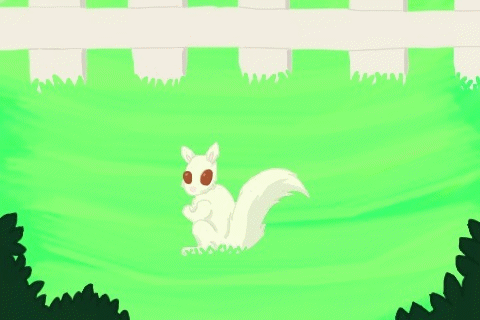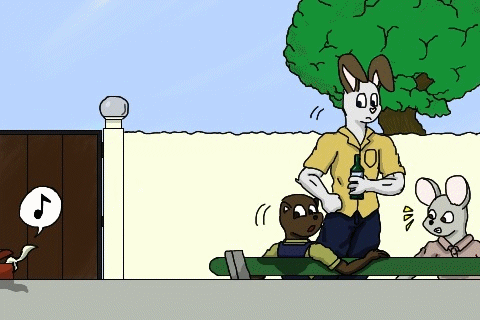 A Spontoon Albino Kaibab Squirrel ('SAKS') in a Casino Island park. (Larger file here - 14 KBytes) - Art by O. T. Grey The Spontoon Albino Kaibab Squirrel A report by E.O. Costello The Spontoon Albino Kaibab Squirrel is yet another example of a (non-anthrop) species introduced into a group of Pacific Islands, though this one seems to have a far less drastic impact than most. As far as can be determined, the initial specimens were brought in during the Colonial period by an eccentric Canadian who was connected with the plantations on what is now Main Island. He may have had as many as a half-dozen of the squirrels, brought in from Canada, as pets. He is believed to have died shortly after the British abandoned the Spontoons, leaving no heir. This resulted in the squirrels escaping into the jungle of Main Island. In spite of the handicap of their snow-white fur, the breeding rate of the squirrels prevailed over the mortality rate, and by the 1920s, populations had established themselves on the Main Island, Meeting Island, and Casino Island. The population on Casino Island thrives the most, generally being fed copious quantities of nuts and crisps by the tourists, especially near the beachside bars. The squirrels here are generally the plumpest and most bushy-tailed, and are photogenic in a certain bizarre sense.  A Spontoon Albino Kaibab Squirrel steals someone's lunch. (Larger file here - 450 KBytes) - Art by O. T. Grey The squirrels on Meeting Island are hunted down more by what is pretty much their biggest predator, the Electricity Department of the Spontoon Ministry of Public Works. Still, Luchow's Restaurant and St. Anthony's Church, for two, have populations of these squirrels on their property. The customers of Luchow's usually feed the squirrels. A few years ago, the Electricity Department began to find increasing problems. As well as semi-fried albino squirrels in some of the powerline equipment. Enough was enough, they decreed. The squirrels had to go. Unfortunately for them, they ran into a number of roadblocks. First were some of the Wise Ones. In the usual fashion, native mythology had been massaged, and the story was the squirrels, far from being introduced by one of the colonials (how blah), were in fact spirit-animals, something their snow-white fur and shiny red eyes admirably suited them for. Second was the opposition of some, like Father Merino over at St. Anthony's on Meeting Island, who point-blank refused to allow the MPW anywhere near the squirrels on the property. Third was the fact that the Ministry of Tourism found out that tourists liked to feed the cute lil' fellas, and their absence from Meeting Island (and the bags of nuts wielded by tourists) was causing comment. All of this, of course, meant that if the DPW wanted to do anything, they had to trap the squirrels alive, in a catch-and-release programme. Herein was the fourth major problem. The little blighters seem to be devilishly intelligent. They are not easy to trap and catch, and even if relocated, find one or more means (whether assisted by sympathetic anthrops or not) to come back to Meeting or Casino Island. MPW, after a few years, has finally thrown in the towel and has given up. Once again, in the early light of morning, you can hear the "Chit-CHIT-irrrrrrrrrrr!" of a SAKS, or watch them chase each other across a well groomed lawn, or collect a handout from a patron of Luchow's. Nature triumphs again. A point the Wise Ones are not loath to make. Even if it is, in this case, not 100% true. So far, it appears the squirrels are breeding true, and the entire known population is white-furred and red eyed. It is not known if Cranium Island takes an interest in the little fellas. |